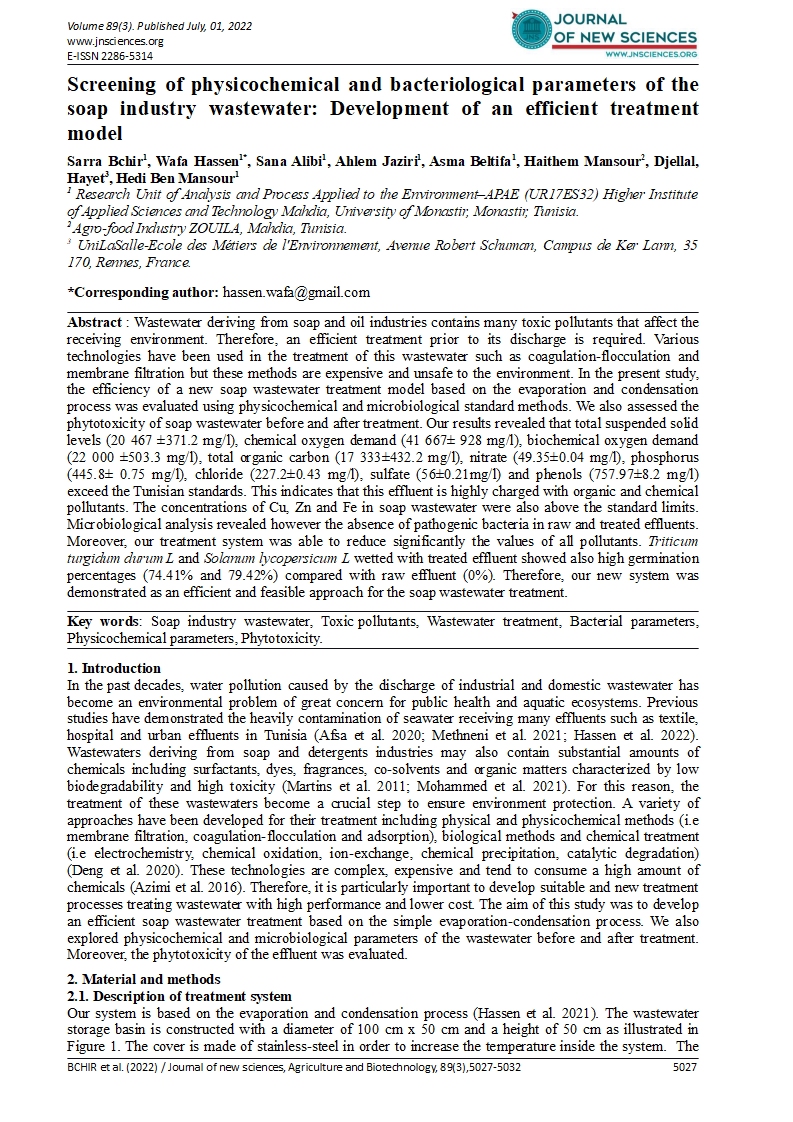

- Category: Volume 89
- Hits: 1027
Screening of physicochemical and bacteriological parameters of the soap industry wastewater: Development of an efficient treatment model
Sarra Bchir1
Wafa Hassen1
Sana Alibi1
Ahlem Jaziri1
Asma Beltifa1
Haithem Mansour2
Djellal, Hayet3
Hedi Ben Mansour1
1 Research Unit of Analysis and Process Applied to the Environment–APAE (UR17ES32) Higher Institute of Applied Sciences and Technology Mahdia, University of Monastir, Monastir, Tunisia.
2 Agro-food Industry ZOUILA, Mahdia, Tunisia.
3 UniLaSalle-Ecole des Métiers de l'Environnement, Avenue Robert Schuman, Campus de Ker Lann, 35 170, Rennes, France.
DOI: https://doi.org/10.55416/sunb.jns01.2207.08903
Abstract : Wastewater deriving from soap and oil industries contains many toxic pollutants that affect the receiving environment. Therefore, an efficient treatment prior to its discharge is required. Various technologies have been used in the treatment of this wastewater such as coagulation-flocculation and membrane filtration but these methods are expensive and unsafe to the environment. In the present study, the efficiency of a new soap wastewater treatment model based on the evaporation and condensation process was evaluated using physicochemical and microbiological standard methods. We also assessed the phytotoxicity of soap wastewater before and after treatment. Our results revealed that total suspended solid levels (20 467 ±371.2 mg/l), chemical oxygen demand (41 667± 928 mg/l), biochemical oxygen demand (22 000 ±503.3 mg/l), total organic carbon (17 333±432.2 mg/l), nitrate (49.35±0.04 mg/l), phosphorus (445.8± 0.75 mg/l), chloride (227.2±0.43 mg/l), sulfate (56±0.21mg/l) and phenols (757.97±8.2 mg/l) exceed the Tunisian standards. This indicates that this effluent is highly charged with organic and chemical pollutants. The concentrations of Cu, Zn and Fe in soap wastewater were also above the standard limits. Microbiological analysis revealed however the absence of pathogenic bacteria in raw and treated effluents. Moreover, our treatment system was able to reduce significantly the values of all pollutants. Triticum turgidum durum L and Solanum lycopersicum L wetted with treated effluent showed also high germination percentages (74.41% and 79.42%) compared with raw effluent (0%). Therefore, our new system was demonstrated as an efficient and feasible approach for the soap wastewater treatment.
Key words: Soap industry wastewater, Toxic pollutants, Wastewater treatment, Bacterial parameters, Physicochemical parameters, Phytotoxicity

